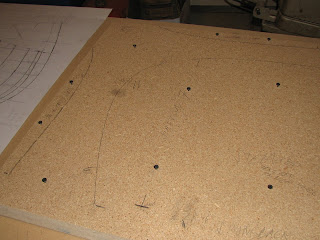
I went to Paxton lumber with my father-in-law, Norm, last Saturday and came back with a piece of douglas fir and another of birch. Parts of both pieces have now been ripped into 3/16" strips for the laminated stems of the boat, with the softer douglas fir being used for inner stems, and the harder, more abrasion resistant birch being used for the outer stems, which will probably get a bit banged up at some point. I could have used something harder, like maple for the outer stems, but birch should work just fine and it's a little lighter, since I'm trying to keep the weight down. For a little contrast in the outer stem, I also ripped a strip of some red oak that I got off of freecycle. I'd put up a picture, but the camera's batteries are dead.
I could have used something lighter for the inner stems, like spruce or pine, to keep the weight down some, but I needed the douglas fir for the laminated paddles that I'm making. While I also want to keep the paddles light, the fir is a nice medium between a heavy and thin paddle from hardwoods and light and thick paddle from softwoods. Ideally, I'd alternate heavy and light woods, with the heavy hardwoods in the thin areas and light softwoods in the thick areas of the paddle. But, I had some maple on hand from the same freecycle donor as the oak that I wanted to use (I also got a bunch of studs and 1 x 12's from them). Since maple has a high ratio of expansion, I needed something that more closely matched it than the lower ratios of the lighter softwoods. Plus, since this is my first paddle, it will be sturdier with the medium density fir. The wide grain of the fir makes a nice constrast with the lighter grain of the maple, don't you think?
My original plan was cut out all the wood to make two paddles, but it didn't quite work out that way. The blade of my table saw kept going off course so that I couldn't get a straight cut. Since the maple was 3/4" thick and I needed two lengths as close to 3/8" thick as I could get them for the paddle laminations, I ended ruining one of the two pieces of maple that I had. I managed to salvage the other piece, but the paddle will now be about 1/4" less wide than the pattern called for and on the thin side.
My table saw is a genuine antique Craftsman, probably older than my dad, and possibly as old as my grandfather. (yeah, I got it off of freecycle, too; I love that site! :-) It has a 1/2" shaft, and all my saw blades have 5/8" augers. The guy who gave me the saw had included a bushing to adapt the blades to the shaft. My theory is that when the blade heated up and expanded, the bushing, which is only 1/16" thick, slid off to the side of the blade and into the hollow in the washers. This allowed the blade drop and wiggle all over the place. I got a couple more bushings today, put them on in addition to the other bushing, and it now cuts like a dream! It might also help that I used a newer blade instead of the ones the guy included with the saw that looked like they might be just as old.
So, now that the saw is working well, I hauled it out into the driveway to rip the strips for the stems. It was frigid work, considering that the temperature dropped and we got about 12" of snow dumped on us this week, but I needed to get the inner stem thickness figured out before I could cut the forms for the stem. And the driveway had been shoveled by the HOA, so at least I had room for it! If I can get a few more pieces cut out for projects like the seats and thwart, then I can at least have them ready to work on inside when the weather turns nasty again in the future.



